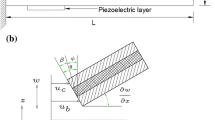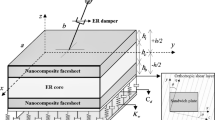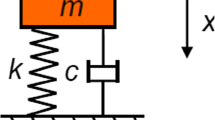Abstract
Background
Vibration control is very significant issue in various engineering fields such as flexible structures, rotor systems, cable and bridge, and vehicle suspension. So far, three different recipes to suppress or control unwanted vibrations are used: passive, semi-active and active. As well known, the passive method has several limitations, such as the lack of real-time avoidance of the time-varying resonances. On the one hand, active vibration control method is very effective, but it is not attractive in terms of cost due to the use of several actuators and sensors. Therefore, recently semi-active vibration control method is popularly used in many practical environments.
Purpose
This article reviews vibration control of flexible structures using the semi-active method associated with smart materials of electrorheological fluids, magnetorheological fluids and magnetorheological elastomers. Modal characteristics of beam, shell and plate incorporating the core (or layer) of smart materials are deeply investigated and discussed in terms of field-dependent controllability.
Methods
The field-dependent natural frequency and damping property of the sandwich beam type, plate type and shell type are experimentally identified. Subsequently, an appropriate control scheme based on the field-dependent modal properties is formulated to avoid the resonance behavior. In addition, several sandwich beams which are partially filled and fully filled with the magnetorheological fluid are investigated to understand the effectiveness of the modal property change.
Results
It has shown that both damping and stiffness properties of the sandwich structures can be effectively controlled by several ways: the change of the field intensity, the location of cores zones, the partial and full treatment and boundary conditions of the structures. In addition, it has identified that mode shapes of the sandwich plates featuring electrorheological core can be partially and fully controlled by applying the input field to an appropriate zone.
Conclusion
Smart flexible structures associated with the field-responsive materials can be effectively used for vibration control due to its controllability of the stiffness and damping as well. However, to successfully implement in real environment, a more sophisticated analytical model considering the microscopic aspects of the particle motions needs to developed. Moreover, the field-dependent bucking problem and acoustic characteristics of smart structures subjected to external disturbances need to be explored.












Similar content being viewed by others
References
Yanik A, Aldemir U, Bakioglu M (2016) Seismic vibration control of three dimensional structures with a simple approach. J Vib Eng Technol 4(3):235–247
Routaray B, Nandi A, Neogy S (2008) Vibration control of a beam using an Eddy current damper. Adv Vib Eng 7(4):377–387
Beltran-Carbajal F, Silva-Navarro G, Vazquez-Gonzalez B (2016) Multi-frequency harmonic vibration suppression on mass-spring-damper systems using active vibration absorbers. J Vib Eng Technol 4(1):1–12
Roy H, Dutta JK, Datta PK (2013) Dynamic behavior of stepped multilayered viscoelastic beams a finite element approach. J Vib Eng Technol 12(1):75–88
Huang Z, Zhang Q, Du C, Li Y (2011) Nonlinear vibration of a viscoelastic beam subjected to both axial forces and transverse magnetic field. J Vib Eng Technol 10(2):167–176
Aravindhan TS, Gupta K (2006) Application of magnetorheological fluid dampers to rotor vibration control. Adv Vib Eng 5(4):369–380
Gupta K, Pandey RK, Reddy RK, Banda MN, Dodiya JS, Patil NS (2014) Analysis and design of a magnetorheological (MR) fluid finite squeeze film damper. J Vib Eng Technol 2(4):327–334
Xu Z, Gong X, Chen X (2011) Development of a mechanical semi-active vibration absorber. J Vib Eng Technol 10(3):229–238
Zhang Q, Ji T (2012) Optimum design parameters for a tuned-mass-damper to maximise the equivalent damping ratio. J Vib Eng Technol 11(4):349–360
Kolekar S, Venkatesh K, Oh JS, Choi SB (2017) The tenability of vibration parameters of a sandwich beam featuring controllable core: experimental investigation. Adv Acoust Vib. https://doi.org/10.1155/2017/5674032 (Article ID 5674032)
Kolekar S, Venkatesh K, Choi SB (2017) Application of semi-active MR fluid sandwich beam for defence vehicles. J Mech Eng Res Dev 40(3):490–500 (ISSN:1024-1752)
Kerwin EM (1959) Damping of flexural waves by a constrained viscoelastic layer. J Acoust Soc Am 31(7):952–962
Rubayi NA, Charoenree S (1966) Natural frequencies of vibration of cantilever sandwich beams. Comput Struct 6:631–645
Gandhi MV, Thompson BS, Choi SB, Shakir S (1989) Electro-rheological-fluid-based articulating robotic systems. ASME J Mech Transm Autom Des 111(3):328–336
Gandhi MV, Thompson BS, Choi SB (1989) A new generation of innovative ultra-advanced intelligent composite materials featuring electro-rheological fluids: an experimental investigation. J Compos Mater 23(12):1232–1255
Gandhi MV, Thompson BS, Choi SB (1989) A proof-of-concept experimental investigation of a slider-crank mechanism featuring a smart dynamically-tunable connecting-rod incorporating embedded electro-rheological fluid domains. J Sound Vib 135(3):511–515
Shin YS, Maurer GJ (1991) Vibration response of constrained viscoelastically damped plates: analysis and experiments. Finite Elem Anal Des 6:291–296
Ma BA, He JF (1992) A finite element analysis of viscoelastically damped sandwich plates. J Sound Vib 152(1):106–123
Choi SB, Park YK, Jung SB (1999) Modal characteristics of a flexible smart plate filled with electrorheological fluids. AIAA J Aircr 36(2):458–464
Khatri KN (1996) Axisymmetric vibration of multilayered conical shells with core layers of viscoelastic material. Comput Struct 58(2):389–406
Korjakin A, Rikards R, Chate A, Altenbachb H (1998) Analysis of free damped vibrations of laminated composite conical shells. Compos Struct 41:39–46
Choi SB (1990) Control of single-link flexible manipulators fabricated from advanced composite laminates and smart materials incorporating electro-rheological fluids. Ph.D. Dissertation, Department of Mechanical Engineering, Michigan State University, East Lansing, USA
Choi SB, Thompson BS, Gandhi MV (1992) An experimental investigation on smart laminated composite structures featuring embedded electro-rheological fluid domains for vibration-control applications. Compos Eng 2:543–559
Choi SB, Park YK, Kim JD (1993) Vibration characteristics of hollow cantilevered beams containing an electro-rheological fluid. Int J Mech Sci 35(9):757–768
Choi SB, ParkYK SuhMS (1994) Elastodynamic characteristics of hollow cantilever beams containing an electro-rheological fluid: experimental results. AIAA J 32(2):438–440
Choi SB, Thompson BS, Gandhi MV (1995) Experimental control of a single-link flexible arm incorporating electro-rheological fluids. AIAA J Guid Control Dyn 18(4):916–919
Choi SB, Park YK, Cheong CC (1996) Active vibration control of intelligent composite laminate structures incorporating an electro-rheological fluid. J Intell Mater Syst Struct 7(4):411–419
Gong H, Lim MK, Tan BC (1993) Influence of a locally applied electro-rheological fluid layer on vibration of a simple cantilever beam. J Intell Mater Syst Struct 4:369–384
David, John B (1991) Damped composite structures. Compos Struct 18:283–294
Mahjoob M, Martin HR, Ismail F (1995) Identification of damping and stiffness of smart structures incorporating ER fluids. Appl Acoust 45:211–226
Yalcintas M, Coulter JP (1995) An adaptive beam model with electrorheological material based applications. J Intell Mater Syst Struct 6:498–506
Oyadiji SO (2003) Controlling tube vibration using an electrorheological fluid”. J Intell Mater Syst Struct 14:113–116
Choi SB, Seo JW, Kim JH, Kim KS (2001) An electrorheological fluid-based plate for noise reduction in a cabin: experimental results. J Sound Vib 239(1):178–185
Park YK, Choi SB (1999) Vibration control of a cantilevered beam via hybridization of electro-rheological fluids and piezoelectric films. J Sound Vib 225(2):391–398
Yeh JY, Chen LW (2005) Dynamic stability of a sandwich plate with a constraining layer and electrorheological fluid core. J Sound Vib 285:636–652
Yeh JY, Chen LW (2006) Finite element dynamic analysis of orthotropic sandwich plates with an electrorheological fluid core layer. Compos Struct 68:368–376
Rezaeepazhand J, Pahlavan L (2009) Transient response of sandwich beams with electrorheological core. J Intell Mater Syst Struct 20:161–169
Yeh JY (2011) Free vibration analysis of rotating polar orthotropic annular plate with ER damping treatment. Compos Part B 42:681–688
Hasheminejad SM, Fadavi-Ardakani A (2017) Elasto-acoustic response damping performance of a smart cavity-coupled electro-rheological fluid sandwich panel. J Sandw Struct Mater. https://doi.org/10.1177/1099636216673857
Yalcintas M, Dai H (1999) Magnetorheological and electrorheological materials in adaptive structures and their performance comparison. Smart Mater Struct 8:560–563
Wang J, Meng G (2001) Magnetorheological fluid devices: principles, characteristics and applications in mechanical engineering. Proc Inst Mech Eng Part L 215:165–174
Sun Q, Zhou JX, Zhang L (2003) An adaptive beam model and dynamic characteristics of magnetorheological materials. J Sound Vib 261:465–481
Pranoto T, Nagaya K, Hosoda A (2004) Vibration suppression of plate using linear MR fluid passive damper. J Sound Vib 266:919–932
Yeh ZF, Shih YS (2006) Dynamic characteristics and dynamic instability of magnetorheological material-based adaptive beams. J Compos Mater 40(5):1333–1359
Rajamohan V, Rakheja S, Sedaghati R (2010) Vibration analysis of a partially treated multi-layer beam with magnetorheological fluid. J Sound Vib 329:3451–3469
MalekzadehFard K, Gholam M, Reshadi F (2017) Free vibration and buckling analyses of cylindrical sandwich panel with magneto-rheological fluid layer. J Sandw Struct Mater 19(4):397–423
Joshi SB (2012) Vibration study of magnetorheological fluid filled sandwich beams. Int J Appl Res Mech Eng 2(2):100–104
Rajamohan V, Sundararaman V, Govindarajan B (2013) Finite element vibration analysis of a magnetorheological fluid sandwich beam. Procedia Eng 64:603–612
Kamble VG (2014) Analysis of simply supported MR fluid sandwich beam. J Mater Sci Eng 3(3):265
Walikar CA, Kolekar S, Hanumantharaya R, Raju J (2015) A study on vibration characteristics of engine oil based magnetorheological fluid sandwich beam. J Mech Eng Autom 5(3B):84–88
Khedkar YM (2016) Manufacturing and testing of cantilever beam using megnetorheological approach. Int J Innov Eng Technol 7(1):463–469
Wei M, Sun L, Hu G (2017) Dynamic properties of an axially moving sandwich beam with magnetorheological fluid core. Adv Mech Eng 9(2):1–9
Carlson JD, Jolly MR (2000) MR fluid, foam and elastomer devices. Mechatronics 10:555–569
Jolly MR, Carlson JD, Munoz BC, Bullions TA (1996) A model of the behavior of magnetorheological materials. Smart Mater Struct 5:607–614
Demchuk SA, Kuz’min VA (2002) Viscoelastic properties of magnetorheological elastomers in the regime of dynamic deformation. J Eng Phys Thermophys 75:396–400
Zhou GY, Wang Q (2006) Use of magnetorheological elastomer in an adaptive sandwich beam with conductive skins. Part I: magnetoelastic loads in conductive skins. Int J Solids Struct 43:5386–5402
Zhou GY, Wang Q (2006) Use of magnetorheological elastomer in an adaptive sandwich beam with conductive skins. Part II: dynamic properties. Int J Solids Struct 43:5403–5420
Dwivedy SK, Mahendra N, Sahu KC (2009) Parametric instability regions of a soft and magnetorheological elastomer cored sandwich beam. J Sound Vib 325:686–704
Nayak B, Dwivedy SK, Murthy KSRK (2011) Dynamic analysis of magnetorheological elastomers based sandwich beam with conductive skins under various boundary conditions. J Sound Vib 330:1837–1859
Nayak B, Dwivedy SK, Murthy KSRK (2012) Multi-frequency excitation of magnetorheological elastomer-based sandwich beam with conductive skins. Int J Non Linear Mech 47:448–460
Yeh JY (2013) Vibration analysis of sandwich rectangular plates with magnetorheological elastomers damping treatment. Smart Mater Struct 22(3):0964–1726
Dyniewicz B, Bajkowski JM, Bajer CI (2015) Semi-active control of a sandwich beam partially filled with magnetorheological elastomer. Mech Syst Signal Process 60–61:695–705
Vemuluri RB, Rajamohan V, Arumugam AB (2017) Dynamich characterization of tapered laminated composite sandwich plates partially treated with magnetorheological elastomer. J Sandw Struct Mater. https://doi.org/10.1177/1099636216652573
Hu G, Guol M, Li W, Du H, Alici G (2011) Experimental investigation of the vibration characteristics of a magnetorheological elastomer sandwich beam under non-homogeneous small magnetic fields. Smart Mater Struct. https://doi.org/10.1088/0964-1726/20/12/127001
Author information
Authors and Affiliations
Corresponding author
Ethics declarations
Conflict of interest
The authors declare that there is no conflict of interest regarding the publication of this paper.
Additional information
Publisher's Note
Springer Nature remains neutral with regard to jurisdictional claims in published maps and institutional affiliations.
Rights and permissions
About this article
Cite this article
Kolekar, S., Venkatesh, K., Oh, JS. et al. Vibration Controllability of Sandwich Structures with Smart Materials of Electrorheological Fluids and Magnetorheological Materials: A Review. J. Vib. Eng. Technol. 7, 359–377 (2019). https://doi.org/10.1007/s42417-019-00120-5
Received:
Accepted:
Published:
Issue Date:
DOI: https://doi.org/10.1007/s42417-019-00120-5




